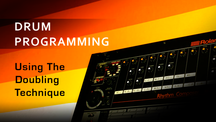It's 3:30 in the afternoon when your phone rings. The head of a music library is calling and she needs your help. They have a commercial for an A-list client that needs music, and they want you to submit an entry. You'll get $10,000 if you land the gig. Oh, and it's due by 5:00.
Sadly this scenario is not all that far off from reality (but that's a discussion for another time). When you have barely minutes to produce a track, chances are you're going to have to rely on pretty standard drum loops to get it done on time. The time needed to program a totally original and complex beat just isn't there.
A lack of time however doesn't mean your track has to be boring. With these simple drum programming tips you can get a lot of life out of a simple drum pattern without much effort.
Double and Change the End
The problem with most drum loops is that they get boring very quickly. And Rule #1 of music is: Never Be Boring! Once your listener becomes bored with something they will tune it out and not really be aware of it anymore.
The trick to making a boring loop seem more interesting is this: Start with a short loop. Double it in length (copy paste), but on the second copy make some small change to the very end, like a variation or a fill. Now take the entire part so far, double it and change the very end. Rinse and repeat. This is the doubling technique.
With this idea you can turn 1 bar into 64 with only 7 unique measures of music.
Why It Works
It's a simple technique and it works for simple reasons.
Beginnings and endings (repeats in the case of a loop) are the most noticeable sections for your listener, and those are the parts that are going to reach their attention.
Generally your listener will be distracted by all the other elements you have going on in the middle, and so variety in the drums won't be as important. It's only when they hear the clean end of a section, usually a 4, 8 or 16 bar part of the song, that they'll even feel any variety in the pattern.
An Example
The basic idea:
- 1 bar loop
- Double it, but modify the last beat
- Double it, but modify the last beat or few beats
- Double it, but modify the last few beats or full bar
- And so on
Copy and paste to double it in length, but modify the last beat.
Do it again to go from 2 bars to 4. This time I'll make a simple snare fill:
Do it again to go from 4 bars to 8. For this one I'll do a bigger fill with toms:
Already we have an 8 measure beat that is not an incessant and repetitive loop. For a 16 bar pattern I would just double the whole thing again and change the last few beats.
Conclusion
This technique can be used for much more than just drums. Think about how you can apply it to other situations. Perhaps an accompaniment part such as a rhythm guitar pattern just needs a little variety to come to life, or an ostinato pattern won't feel so repetitive and hypnotic if you vary it up following the same double and change the end principle.
In no way do I condone this as a way to produce lasting art, but sometimes we have to do the best we can in the amount of time given. In many ways it's like applying the Pareto Principle, aka the 80/20 rule. You could think of the unique changes you make on only a few beats for drum fills as the 20% of actual content, but 80% of what actually reaches your listener's awareness.
















